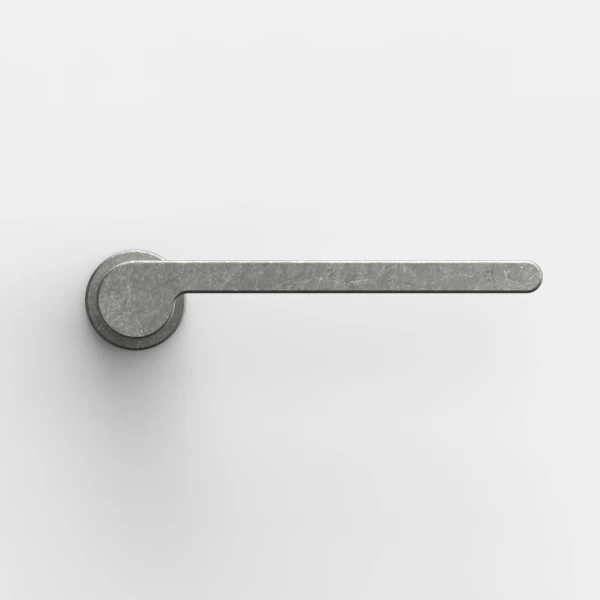Aluminum
The Circular Lightweight
Aluminum is the most abundant metal on Earth—and one of the youngest in industrial use. First produced in 1808, it has since transformed entire industries. From aerospace to automotive, wherever lightness, durability, and precision are key, aluminum is indispensable.

Material with Character
With its silvery sheen and tactile appeal, aluminum set new standards in architecture and interior design starting in the 1950s. FSB's own success story with the material began with Johannes Potente and continues to shape our expertise today. Our cast aluminum products are made from primary aluminum sourced using renewable energy—hydro, wind, and solar—for a CO₂ footprint of less than 4.0 kg CO₂/kg.
Aluminum is endlessly recyclable without any loss in quality. We consistently return production scrap, such as casting sprues from gravity die casting, to the material cycle.
Environmental Certificates
Surfaces and Colors
-
Subtle Elegance: Anodized Aluminum in a True-to-Material Tone
The natural silver tone (FSB 0105) reflects the original quality of the metal. Anodizing creates a durable surface finish: a roughly 10 µm-thick oxide layer protects the aluminum and adds design versatility.
Coloring Method: Two-step electrolytic coloring with a lightfastness level 7–8
The velvety texture remains intact. Over time, wear marks like fine scratches add to the story the material tells.
-

0810
Anodized, Velvety-Matte Surface, Black(C35)
Tactile Dimension Meets Visual Precision
A New Tectonic Surface Language:
Bead-blasting densifies the aluminum before anodizing—creating a finish that is exceptional both to the touch and to the eye. These bead-blasted, anodized surfaces merge industrial precision with architectural elegance.
Coloring Process:
The coloring is achieved using a two-step electrolytic process that ensures lightfastness rated at Level 7-8.
Available Color Variants:FSB 0510: Medium Bronze C33, velvety matte
FSB 0710: Dark Bronze C34, velvety matte
FSB 0810: Black C35, velvety matte
Key Characteristics:
Echo classic metal tones from architectural history
Harmonize with tone-on-tone façade systems
Offer above-average resistance to scratches and impacts
Technical Performance Through Material Transformation
The bead-blasting process does more than refine the aluminum’s appearance—it initiates a metallurgical transformation. Much like forging, the surface structure is compacted, resulting in increased resistance to mechanical stress. Bead-blasted and anodized variants outperform conventionally finished aluminum in their resistance to impact and scratching—a functional dimension that fully matches their aesthetic refinement.
Material Variants in Dialogue with Architecture
FSB draws not only on the material aesthetics of bronze in various patina stages, but also integrates established façade profile standards C33 and C35 (EURAS) into its color spectrum.
This opens up a broad range of design options for diverse architectural contexts. -
Precision in Color
Colored hardware has long evolved beyond mere accents—they are now integral elements of contemporary architectural concepts. As chromatic bridges between façade and interior, they add subtle depth and cohesive continuity to the built environment.
Technology in the Service of Design
At FSB, we see ourselves as specialists in premium metal hardware. Upon request, we offer powder-coated aluminum products that add an additional layer of expression to architectural design.
These are based on precision-cast and ground aluminum models from our standard portfolio.
The multistep finishing process includes:
Special anodic oxidation for surface preparation
Followed by electrostatic powder coating—a solvent-free method that meets the highest environmental standards
The result is a color layer approximately 80 μm thick, offering exceptional lightfastness, surface hardness, and abrasion resistance—ideal for architectural elements subject to frequent use.
Chromatic Variety: Powder-Coated Aluminum
For architectural spaces where chromatic precision is key, FSB offers the following powder-coated aluminum finishes:
FSB 8821: Black, similar to RAL 9005, matte
FSB 8220: White, similar to RAL 9016, glossy
FSB 9020: Pure White, similar to RAL 9010, glossy
FSB 8876: Light Bronze, similar to C31, velvety matte
FSB 8877: Bright Bronze, similar to C32, velvety matte
The powder coating process is solvent-free and meets the highest environmental standards. These finishes offer outstanding lightfastness, surface hardness, and abrasion resistance.
-
Material and Color Preision
RAL color references serve as a guide. Due to the specific coating process and material base, slight deviations from standard reference tones may occur—subtle nuances that underscore the unique materiality and authenticity of our products.
Overview of Color Variants:
FSB 8821: Black, similar to RAL 9005, matte – ideal for understated, material-driven design concepts
FSB 8220: White, similar to RAL 9016, glossy – perfect for spaces with modular lightness
FSB 9020: Pure White, similar to RAL 9010, glossy – the architectural classic for crisp contrasts
FSB 8876: Light Bronze, similar to C31, velvety-matte – adds warmth and texture to refined interiors
FSB 8877: Bright Bronze, similar to C32, velvety-matte – pairs beautifully with natural materials and Mediterranean palettes
Aluminum, Reimagined
Projects featuring Aluminum FSB Products
Additional Materials
A Closer Look at Sustainability
We consistently return all aluminum waste from our production—such as sprues from gravity die casting—back into the material cycle. At FSB, aluminum isn’t just a lightweight material; it’s a heavyweight when it comes to sustainability.
Learn more about how we protect our environmentNewsletter
The FSB Newsletter formats keep you informed about product innovations and current topics.


















